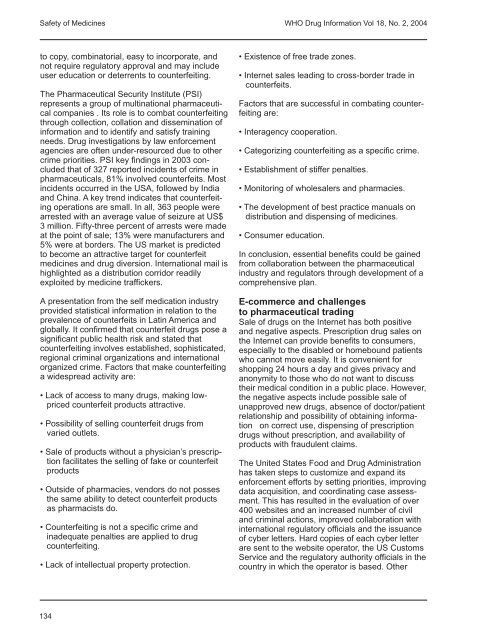WHO Drug Information Vol. 18, No. 2, 2004 - World Health ...
WHO Drug Information Vol. 18, No. 2, 2004 - World Health ...
WHO Drug Information Vol. 18, No. 2, 2004 - World Health ...
You also want an ePaper? Increase the reach of your titles
YUMPU automatically turns print PDFs into web optimized ePapers that Google loves.
Safety of Medicines<br />
to copy, combinatorial, easy to incorporate, and<br />
not require regulatory approval and may include<br />
user education or deterrents to counterfeiting.<br />
The Pharmaceutical Security Institute (PSI)<br />
represents a group of multinational pharmaceutical<br />
companies . Its role is to combat counterfeiting<br />
through collection, collation and dissemination of<br />
information and to identify and satisfy training<br />
needs. <strong>Drug</strong> investigations by law enforcement<br />
agencies are often under-resourced due to other<br />
crime priorities. PSI key findings in 2003 concluded<br />
that of 327 reported incidents of crime in<br />
pharmaceuticals, 81% involved counterfeits. Most<br />
incidents occurred in the USA, followed by India<br />
and China. A key trend indicates that counterfeiting<br />
operations are small. In all, 363 people were<br />
arrested with an average value of seizure at US$<br />
3 million. Fifty-three percent of arrests were made<br />
at the point of sale; 13% were manufacturers and<br />
5% were at borders. The US market is predicted<br />
to become an attractive target for counterfeit<br />
medicines and drug diversion. International mail is<br />
highlighted as a distribution corridor readily<br />
exploited by medicine traffickers.<br />
A presentation from the self medication industry<br />
provided statistical information in relation to the<br />
prevalence of counterfeits in Latin America and<br />
globally. It confirmed that counterfeit drugs pose a<br />
significant public health risk and stated that<br />
counterfeiting involves established, sophisticated,<br />
regional criminal organizations and international<br />
organized crime. Factors that make counterfeiting<br />
a widespread activity are:<br />
• Lack of access to many drugs, making lowpriced<br />
counterfeit products attractive.<br />
• Possibility of selling counterfeit drugs from<br />
varied outlets.<br />
• Sale of products without a physician’s prescription<br />
facilitates the selling of fake or counterfeit<br />
products<br />
• Outside of pharmacies, vendors do not posses<br />
the same ability to detect counterfeit products<br />
as pharmacists do.<br />
• Counterfeiting is not a specific crime and<br />
inadequate penalties are applied to drug<br />
counterfeiting.<br />
• Lack of intellectual property protection.<br />
134<br />
<strong>WHO</strong> <strong>Drug</strong> <strong>Information</strong> <strong>Vol</strong> <strong>18</strong>, <strong>No</strong>. 2, <strong>2004</strong><br />
• Existence of free trade zones.<br />
• Internet sales leading to cross-border trade in<br />
counterfeits.<br />
Factors that are successful in combating counterfeiting<br />
are:<br />
• Interagency cooperation.<br />
• Categorizing counterfeiting as a specific crime.<br />
• Establishment of stiffer penalties.<br />
• Monitoring of wholesalers and pharmacies.<br />
• The development of best practice manuals on<br />
distribution and dispensing of medicines.<br />
• Consumer education.<br />
In conclusion, essential benefits could be gained<br />
from collaboration between the pharmaceutical<br />
industry and regulators through development of a<br />
comprehensive plan.<br />
E-commerce and challenges<br />
to pharmaceutical trading<br />
Sale of drugs on the Internet has both positive<br />
and negative aspects. Prescription drug sales on<br />
the Internet can provide benefits to consumers,<br />
especially to the disabled or homebound patients<br />
who cannot move easily. It is convenient for<br />
shopping 24 hours a day and gives privacy and<br />
anonymity to those who do not want to discuss<br />
their medical condition in a public place. However,<br />
the negative aspects include possible sale of<br />
unapproved new drugs, absence of doctor/patient<br />
relationship and possibility of obtaining information<br />
on correct use, dispensing of prescription<br />
drugs without prescription, and availability of<br />
products with fraudulent claims.<br />
The United States Food and <strong>Drug</strong> Administration<br />
has taken steps to customize and expand its<br />
enforcement efforts by setting priorities, improving<br />
data acquisition, and coordinating case assessment.<br />
This has resulted in the evaluation of over<br />
400 websites and an increased number of civil<br />
and criminal actions, improved collaboration with<br />
international regulatory officials and the issuance<br />
of cyber letters. Hard copies of each cyber letter<br />
are sent to the website operator, the US Customs<br />
Service and the regulatory authority officials in the<br />
country in which the operator is based. Other

















